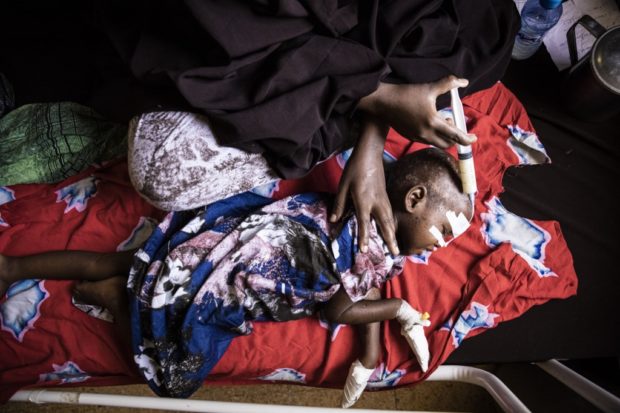
EDITORS NOTE: Graphic content / Ifrah Mohamud feeds her severely malnourished daughter, Najax Ahmed Mahumed, 2, via a tube in Banadir Maternity and Children Hospital in Mogadishu, Somalia, on June 1, 2022. – Four consecutive seasons of poor rains have left millions of drought-stricken people in Kenya, Somalia and Ethiopia facing starvation. (Photo by Ed RAM / AFP)
MOGADISHU, Somalia — As flies buzz over his tiny body, two-year-old Sadak Ibrahim barely whimpers, too weak to cry or shoo them away — a heartbreaking glimpse of the hunger crisis gripping Somalia.
The Horn of Africa nation is on the brink of a second famine in just over a decade, enduring its worst drought in 40 years after failed rainy seasons since late 2020 wiped out crops and livestock.
With a fifth monsoon forecast to fail, the United Nations warned this month that time was running out to save lives as it urged donors to contribute more to the relief effort.
UN humanitarian chief Martin Griffiths said the situation was worse than the 2011 famine when 260,000 people died in the country, more than half of them children under the age of six.
Aid is slowly making its way to Somalia following delays caused by the war in Ukraine, which also sent the cost of transport and emergency supplies soaring.
But many fear the help will arrive too late for the country’s youngest victims like Sadak, with around 730 children already reported dead in nutrition centers between January and July this year, according to UNICEF.
At De Martino Hospital in the capital Mogadishu, Sadak’s anxious mother Fadumo Daud sat vigil by the toddler’s bedside, a feeding tube dangling from his face, as she prayed for a miracle.
“He is the only child I have, and he is very sick as you can see,” the young woman told AFP, recounting the three-day journey that brought her to Mogadishu from Baidoa — one of the epicenters of the crisis.
‘Dramatic increase’
In recent years, climate disasters have increasingly become the main driver of migration in Somalia, which is also grappling with a brutal 15-year Islamist insurgency.
Every day, dozens of people stream into camps set up for displaced families in Mogadishu.
The International Rescue Committee (IRC) non-profit runs seven health and nutrition centers in and around the capital, but their resources are sharply stretched with the crisis showing no signs of abating.
“The number of new arrivals has increased dramatically starting from June this year,” IRC nutrition officer Faisa Ali told AFP.
Most of the children turn up malnourished, she said, with their numbers trebling from a maximum of 13 a day in May to 40 now.
A mother of 10, Nuunay Adan Durow fled her home and traveled 300 kilometers (200 miles) to find medical help for her three-year-old son Hassan Mohamed, his limbs swollen due to severe malnutrition.
“For the last three years, we have not harvested anything due to lack of rain,” Durow told AFP, describing how she was forced to trek for two hours daily to find water for her family.
“We faced a terrible situation,” the 35-year-old said, cradling Hassan in her arms as they awaited medical attention at an IRC centre on the outskirts of Mogadishu.
‘The worst cases’
The drought has also affected parts of Kenya and Ethiopia but the risks for Somalia are particularly grave, with 200,000 people in danger of starvation and around 1.5 million children facing acute malnutrition by next month, the UN says.
The crisis has not spared even traditionally fertile regions such as Lower Shabelle, where drought-stricken communities would seek refuge in the past, hoping to find sustenance there.
“We used to farm and get vegetables to feed our children before the drought affected us,” Fadumo Ibrahim Hassan, 35, told AFP.
Now “we live on whatever God gives us,” the widowed mother-of-six said.
A recent arrival in Mogadishu, her two-year-old daughter Yusro’s condition had deteriorated to the point that the IRC staff could no longer care for her.
Weighing just 5.8 kilograms (12.8 pounds) — half that of a healthy girl the same age — Yusro was dangerously malnourished, according to the IRC medical team, who told AFP she urgently needed to be admitted to a hospital.
At De Martino Hospital, doctor Fahmo Ali told AFP that each day brought more sick, malnourished children into her care.
“The ones we are receiving here are the worst cases with complications,” she said.
“Sometimes those we have treated come back to the hospital after getting sick again.”